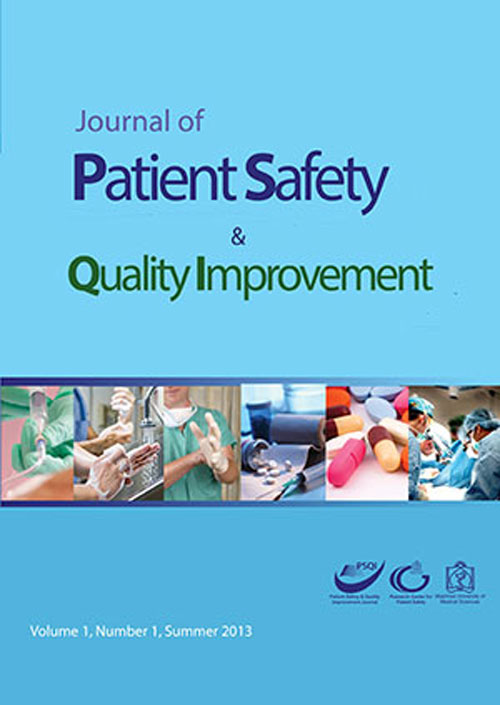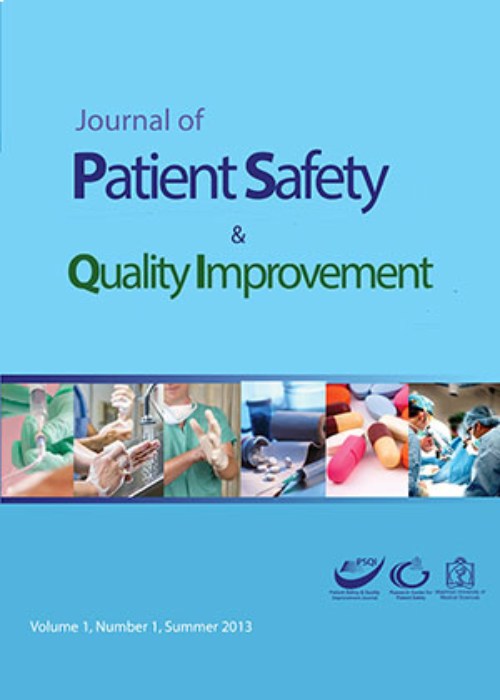فهرست مطالب

Journal Of Patient safety and quality improvement
Volume:10 Issue: 1, Winter 2022
- تاریخ انتشار: 1401/01/16
- تعداد عناوین: 5
-
Pages 3-9IntroductionThe present study aimed to assess the effect of pulmonary hypertension (PH) severity on the quality of life after transplantation in patients with end-stage renal disease (ESRD).Materials and MethodsIn this cohort study, 60 ESRD patients who underwent kidney transplantation were followed for at least one year. Basic and laboratory findings were recorded in patients before and after transplantation. Quality of life was assessed by the 12-item health-related quality of life questionnaire (SF-12). The severity of PH was assessed based on pulmonary artery systolic pressure (PASP), and severe cases were excluded from the study. The obtained data were analyzed in SPSS software (version 24) using the chi-square test, independent t-test, and Pearson's correlation.ResultsBased on the results, PH was observed in 83.3% of patients before transplantation. Following transplantation, there was a significant increase in quality of life and glomerular filtration rate (GFR) (P=0.001). Patients with PH had a lower quality of life before transplantation, as compared to those without PH (P= 0.009). Furthermore, the PASP level showed a significant positive relationship with the age of patients (r= 0.465; P<0.001) and the rate of improvement in quality of life after transplantation (r=0.288; P= 0.02).ConclusionAs evidenced by the results of this study, kidney transplantation improves kidney function and the quality of life of patients. The presence of PH leads to lower quality of life in ESRD patients before transplantation but has no effect on it after transplantation. Moreover, the severity of PH had no effect on the outcomes of a kidney transplant.Keywords: End-stage kidney failure, Kidney Transplantation, Pulmonary hypertension, Quality of life
-
Pages 11-18IntroductionDue to the spreading of coronavirus infection in 2019 (COVID-19) throughout the world, tracking cell blood count (CBC) of moderate to severe COVID-19 patients could provide new insights for the prognosis prediction.Materials and MethodsIn this observational-retrospective study, D-dimer and CBC documents of 320 confirmed COVID-19 patients hospitalized in Shamsoshomus Clinic, Mashhad, Iran, were evaluated. Receiver operation characteristics (ROC) curve was analysed to determine specificity and sensitivity of D-dimer and hematological indices, including white blood cell (WBCs), lymphocytes, monocytes, eosinophil, red blood cell width (RDW), platelets (PLT), and mean of platelet volume (MPV).ResultsThis study included 157 (49.1%) male and 163 (50.3%) female COVID-19 patients between 14 to 96 years old. According to their status in the duration of hospitalization, patients were considered in the good outcome group (N=215) and poor outcome group (N=105). A significant difference was observed in D-dimer, WBCS, PMN, Lymph, monocytes, eosinophil, and RDW between the two groups (P<0.001). The highest sensitivity and the lowest specificity belonged to RDW (99%, 4%), WBCs (98%, 4%), PMN (99%, 11%) and D-dimer (96%, 42%). D-dimer indicated a significant association with WBCs, PMN, and RDW (P<0.05).ConclusionThe present study revealed that WBCs and RDW might be recommended for the COVID-19 prognosis prediction due to their high comparable sensitivity to D-dimer.Keywords: Cell Blood count, COVID-19, Prognosis Red blood cell width, white blood cell, sensitivity, specificity
-
Pages 19-24IntroductionAspergillus rhinosinusitis is a potentially lethal complication in patients with underlying immunodeficiencies. Critical laboratory findings, such as lymphopenia and leukocytosis, were highly reported in coronavirus disease 2019 (COVID-19) patients. Based on the correlation between COVID-19 and fungal infections, this study was designed to evaluate the hematologic parameters in COVID-19 patients associated with Aspergillus rhinosinusitis in northeaster Iran.Materials and MethodsDuring eight months and among 80 COVID-19 patients suspected of fungal rhinosinusitis, in two tertiary referral hospitals of Mashhad, hematological parameters, such as white blood cell (WBC) count, of 14 patients affected to COVID-19 with Aspergillus rhinosinusitis were precisely evaluated to check leukopenia and leukocytosis.ResultsThe patients showed a range of 42 to 67 years old and a median age of 59. Of the 14 patients, 8 (57.4%) had diabetes mellitus, 9 (64.2%) died, and two patients has normal leukocyte count. The three, two, and one patients showed leukocytosis, lymphopenia, and leukopenia, respectively. The combination of leukocytosis and lymphopenia was significant in four patients. However, leukopenia and lymphopenia were observed in just one subject. Moreover, leukopenia, lymphopenia, and neutropenia were detected together in one case.ConclusionAspergillus rhinosinusitis had high mortality among COVID-19 patients. Moreover, the high rate of diabetes mellitus was a severe predisposing factor for COVID-19-associated Aspergillus rhinosinusitis. Leukocytosis (neutrophilia) and lymphopenia were the most common hematological abnormalities among COVID-19 patients with Aspergillus rhinosinusitis.Keywords: Aspergillus rhinosinusitis, COVID-19, Infection, Mortality, hematological parameters
-
Pages 25-33IntroductionThe heavy workload of nurses in major healthcare institutions within the Kingdom is attributed to the high turnover and shortage of the nursing workforce. As a result, nurses double their efforts to compensate for the nursing care hours needed by patients under their care which eventually may lead to job dissatisfaction.Materials and MethodsThe study's objectives were met using a quantitative research design. A total of forty-nine (n=49) staff nurses, head nurses, and admitted patients (n=29) in the in-patient wards and intensive care units participated in this study. Seventy percent response rate was obtained among nurses, highlighting the strength of this study's empirical findings. Mueller and McCloskey Satisfaction Scale (MMSS) was used to measure nurses' job satisfaction in several domains. The patient quality of care was described using the Patient Satisfaction with Nursing Care Quality Questionnaire (PSNCQQ). To ensure the tool's reliability and validity, it underwent content and face validity. Cronbach’s alpha for both tools indicated stronger internal consistency. Descriptive statistics and analysis of variance (ANOVA) was performed to determine the influence of several variables to nurses’ job satisfaction domains and quality of nursing care.ResultsNumerical evidence from this study suggested that the nurse respondents were moderately satisfied with most of the satisfaction domains: coworkers, praise and recognition, interaction opportunities, and professional opportunities. Meanwhile, nurses are neutral regarding control and responsibility, the balance of family and work, extrinsic rewards, and scheduling domains, implying that some of their needs were met while others were not, leaving them neither satisfied nor dissatisfied. Some predictors were found to have affected the nurses' job satisfaction. The nursing care quality received an excellent score from patient-respondents, indicating that even though nurses are not completely satisfied, they continue to provide the highest quality care the patient deserves. Age, gender, nationality, and patient length of stay in the hospital are insignificant determinants of nursing quality care.ConclusionNurses' job satisfaction is influenced by their nationality, highest educational attainment, and monthly income. Job satisfaction has no bearing on nursing quality care, but further research is needed to confirm this assumption.Keywords: Job satisfaction, Job Satisfaction Domains. Mueller, McCloskey Satisfaction Scale, Quality of nursing care, PSNCQQ
-
Pages 35-40IntroductionThe COVID-19 Pandemic has been widely accepted as a challenging period for the medical community. The impact of the virus posed challenges on the surgical service provisions in the General Surgery department at a large acute NHS trust. The department learnt to adapt to the challenges and changes in the system which can be summarised into 4 phases, ‘Alarm’, ‘Resuscitation’, ‘Stabilisation’ and ‘Adaption’.Materials and MethodsThe General Surgical department implemented a ‘Gold Command’, ‘Silver Command’ and ‘Platinum Command’ hierarchal system as a systematic method to make decisions to implement change. To assess the outcomes, electronic records were reviewed for number of NCEPOD cases, emergency laparotomies, elective surgeries that took place over the trust and these were compared at each phase.ResultsBetween 26/03/20-30/09/20 a total of 1578 surgeries took place, of which 869(55.1%) were emergency operations, from that 152(17.5%) were emergency laparotomies. 709(45.9%) were elective operations, 197(27.8%) performed at the satellite hospitals, 468(66.0%) performed at King George’s hospital and 44(6.2%) at Queen’s Hospital.ConclusionThe BHRUT General Surgery Department has successfully implemented a system to work through the pandemic to minimise its effects on surgical provisions. This template can act as a guide to nationwide hospitals if ever faced again with a similar challenge.Keywords: COVID19, General Surgery, management


